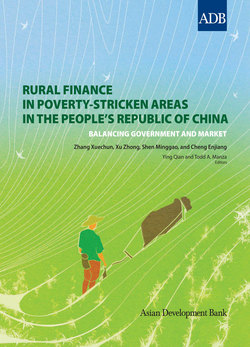Читать книгу Rural Finance in Poverty-Stricken Areas in the People's Republic of China - Xuechun Zhang - Страница 37
На сайте Литреса книга снята с продажи.
Postal Savings Reform
ОглавлениеThe reform of postal savings is an important part of the state postal system reform. Since 2001, the PBC, the Ministry of Finance, and the Ministry of Posts and Telecommunications have conducted a number of studies and proposed a reform scheme under which different interest rates apply to deposits before and after a cutoff date, and postal savings offices have been encouraged to expand their business scope. In 2003, the National Development and Reform Commission played a leading role in coordinating with relevant ministries and commissions and proposing to the State Council a postal system reform plan that would enable postal savings offices to utilize their funds independently and promote commercial viability of postal savings.
After 1 August 2003, the PBC changed the interest on deposits from postal savings. According to the new method, the interest rate on new deposits with the PBC was the same as that on financial institutions’ reserves (1.89% per year), while the previous interest rate (4.13% per year) remains applicable to deposits before August 2003. At the same time, postal savings offices were allowed to utilize new savings at their own discretion.
Under such circumstances, postal savings maintained rapid growth. As of the end of 2002, postal savings outstanding stood at CNY736.9 billion. Two-thirds of these deposits were from rural areas and all were deposited with the central bank. As of August 2006, postal savings outstanding was more than CNY1.5 trillion, an amount exceeded only by the four state-owned commercial banks. The Postal Savings Bank of China (PSBC) also boasts the largest financial network in the nation, connecting urban and rural areas through more than 37,000 outlets, two-thirds of which are in rural areas.
An important part of the central government’s postal system reform was to reform the postal savings management system and standardize the operations of financial services provided by postal savings offices. The general reform plan called for a gradual shift from the previous operational model, in which all savings were deposited with the PBC, to independent utilization of savings under the supervision of the PBC and the China Banking Regulatory Commission. Savings deposited before the cutoff date of 1 August 2003 would continue to follow previous policies until 1 August 2005, whereas new savings were utilized at the discretion of postal savings offices. After 1 August 2005, postal savings offices’ deposits with the PBC would be transferred out over 5 consecutive years. As of 21 March 2006, three such transfers—totaling CNY62.2 billion—were made without affecting the operation of the postal savings offices.
The second element of reform was the gradual diversification of the use of postal savings funds. With previous savings gradually transferred out of the PBC, the ability of postal savings offices to utilize funds independently has been improving. They have adapted to rural financial reform and have piloted pledged microcredit to reinforce support for agricultural industry, rural areas, and farmers (sannong). In December 2005, the China Banking Regulatory Commission approved microcredit lending to rural residents, using time deposit certificates as pledges, in Fujian, Hubei, and Shaanxi provinces.
As of August 2006, independent fund use outstanding exceeded CNY800 billion, most of which was in bonds or was deposited with banks. The China Development Bank was selected as China Post’s partner in the lending business. In June 2006, the two parties signed a comprehensive agreement to cooperate in a variety of areas, such as asset management, fund use, consulting services, human resources, and settlement.
On 31 December 2006, the China Banking Regulatory Commission approved the incorporation of the Postal Savings Bank of China, permitted China Post to become the sole investor in the PSBC, and approved the creation of the fifth-largest commercial bank in the PRC. According to the articles of association, the PSBC operates through the China Post network, must establish an internal control and risk management system in accordance with corporate governance and other requirements for commercial banks, and must operate in line with market principles. Similar to other banks, the institutional arrangement, operations, and senior management are subject to banking supervision focused on the bank’s capital adequacy ratio. The PSBC is well positioned to rely on its current network of outlets to improve financial services with retail and intermediary businesses in both urban and rural areas.
After its transformation from China Post, the biggest problem now facing the PSBC is inadequate lending capacity. It was not until August 2003 that postal savings deposits were gradually transferred out of the central bank and new savings were available for utilization at the discretion of the PSBC, which mainly purchased bonds and deposits under negotiated terms. Since 2006, the China Banking Regulatory Commission has allowed China Post to launch pilot programs of microcredit pledged with deposit certificates, interbank deposits, and investment in syndicated loans and bonds issued by international development agencies. As of August 2006, the balance of independently utilized funds exceeded CNY800 billion, but most of the funds were still invested in bonds or deposited with banks.
